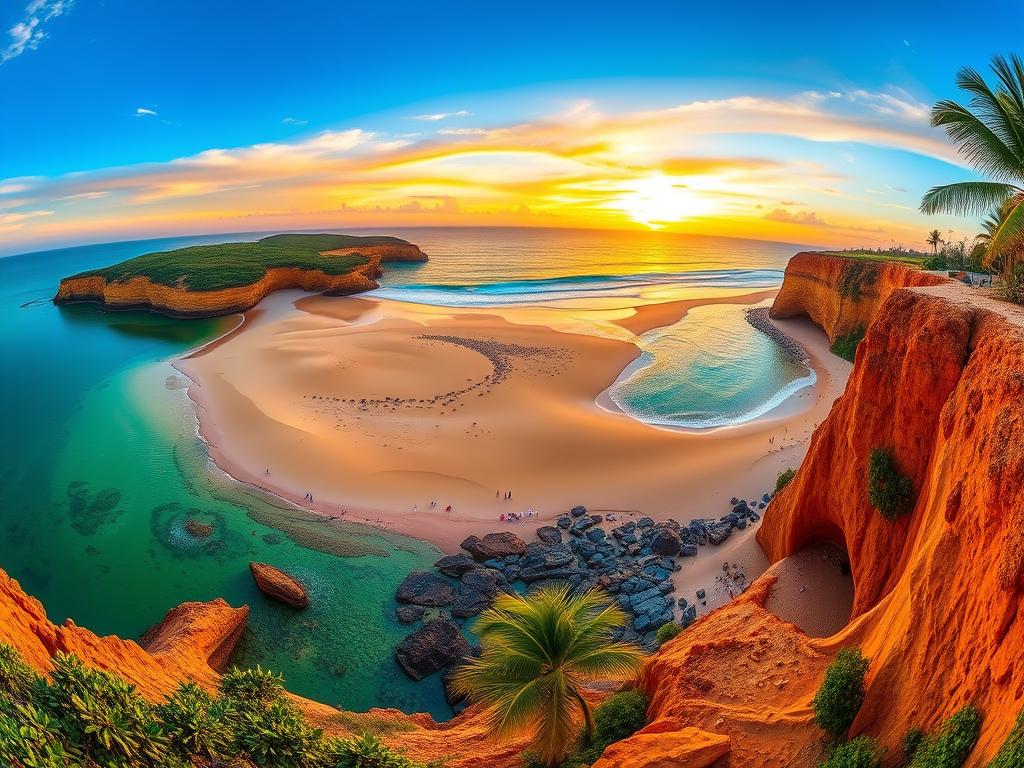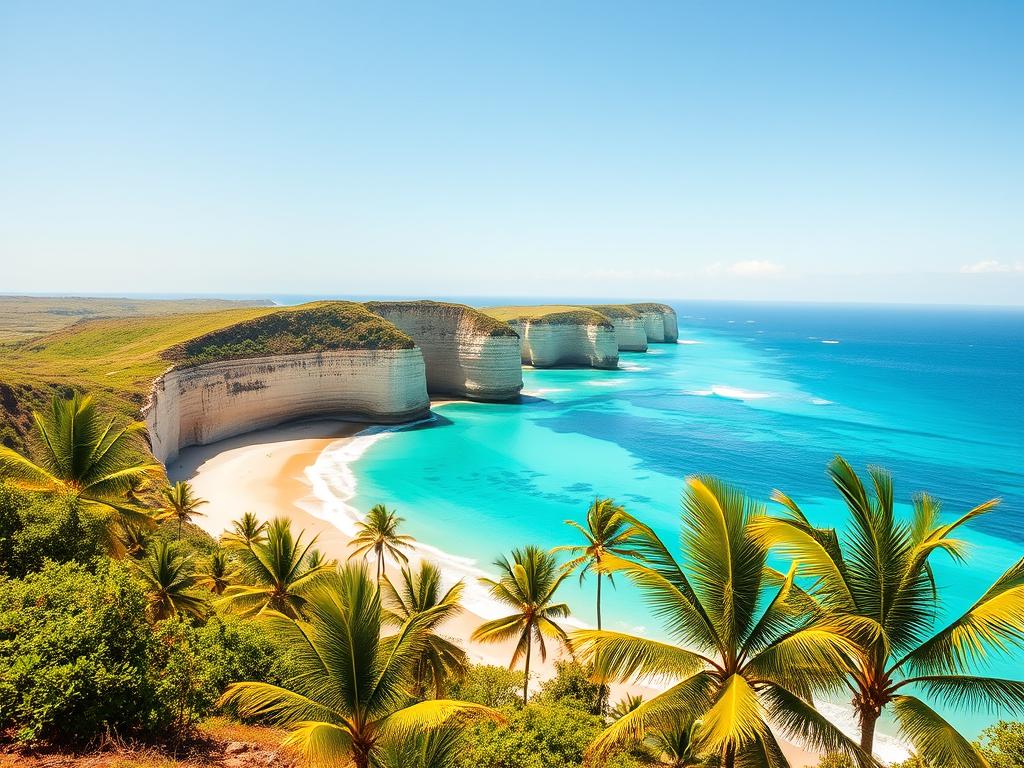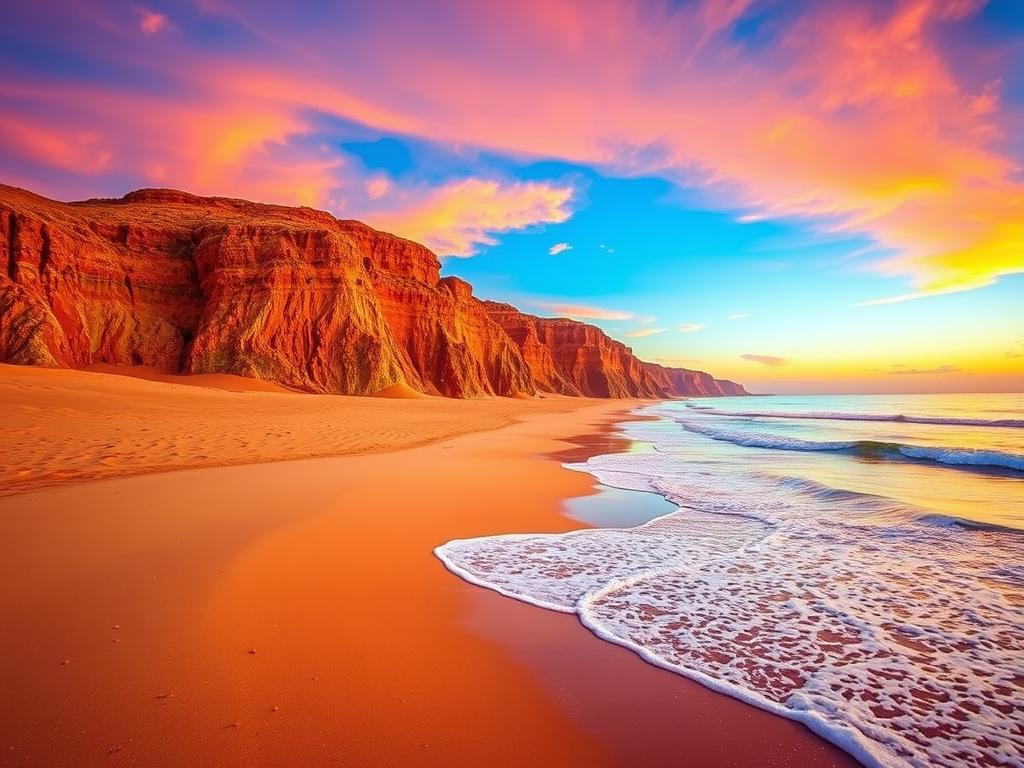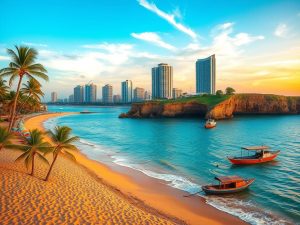
Ceará, in northeastern Brazil, is famous for its beautiful coastlines and beaches. It has everything from Jericoacoara’s sandy dunes to Canoa Quebrada’s lively shores. The state’s 573-kilometer coastline is a mix of coconut groves, dunes, mangrove wetlands, and colorful cliffs.
Beaches like Jericoacoara, Canoa Quebrada, Morro Branco, and Cumbuco are top spots. Each beach has its own special charm, drawing visitors from all over.
Ceará’s Stunning Coastline: A Paradise of Beaches and Cliffs
Ceará, in northeastern Brazil, has a stunning coastline along the Atlantic Ocean. It’s a paradise for those who love beaches and nature. The colorful cliffs and wide ceara coastline and brazil beaches make it breathtaking.
Vibrant Landscapes and Diverse Geography
The coastal plain of Ceará is full of coastal landscapes. You’ll find lush coconut groves, rolling dunes, and calm mangrove wetlands. The ocean, wind, and sand have shaped these wonders, making them both beautiful and varied.

Coconut Groves, Dunes, and Mangrove Wetlands
Exploring Ceará’s ceara geography reveals amazing natural sights. Coconut palms tower over the sand, their leaves moving in the breeze. The dunes stretch far, shaped by the wind. And in the estuaries, mangrove wetlands provide homes for many plants and animals.
These landscapes together make Ceará’s coast a unique and unforgettable place. It’s sure to impress everyone who sees it.
The Best Beaches in Ceará: From Jericoacoara to Canoa Quebrada
Ceará, in northeastern Brazil, is famous for its stunning beaches. Places like Jericoacoara and Canoa Quebrada offer unique beach experiences. These spots, along with Morro Branco and Tatajuba, make Ceará a paradise for beach lovers.
Canoa Quebrada is a favorite beach town, 160 km from Fortaleza. It’s known for its beautiful beaches and colorful cliffs. The best time to visit is from July to December, when the weather is dry and pleasant.
| Destination | Distance from Fortaleza | Travel Time | Airport Proximity |
|---|---|---|---|
| Canoa Quebrada | 160 km | 2-2.5 hours | 20 km (Aracati Airport) |
| Jericoacoara | 300 km | 4-4.5 hours | 40 km (Jericoacoara Airport) |
| Morro Branco | 120 km | 1.5-2 hours | 35 km (Fortaleza Airport) |
| Cumbuco | 35 km | 40 minutes | 20 km (Fortaleza Airport) |
Canoa Quebrada has simple accommodations but offers a variety of places to stay. You can find everything from budget-friendly pousadas to luxury resorts. The Tranquilandia Village, Tatajuba, Vila Canoa, and Pousada do Toby are top choices.

Ceará is not just about its beaches. It’s also known for its natural beauty, pleasant weather, and many activities. Whether you love surfing, eco-tourism, or just relaxing on the beach, Ceará has it all.
Jericoacoara: A Cosmopolitan Beach Destination
Jericoacoara, known as Jeri, is a top spot in Ceará. It’s a former fishing village turned into a trendy place. People from all over come for its beautiful beaches and relaxed vibe.
Pristine Sands and Laid-Back Vibes
Jericoacoara, Brazil is famous for its stunning views. The town is surrounded by tall dunes and has clear waters. It’s a peaceful spot, even with more visitors.
The town got electricity in 1998, starting a new chapter. It’s a favorite for windsurfers and kiteboarders. You can find cozy pousadas, rustic lodges, and fancy hotels to stay.
“Jericoacoara is a place where time stands still, where the only sounds are the whispers of the wind and the lapping of the waves.”
The Brazilian government made Jericoacoara a protected area in 1984. It keeps the beach beautiful. With its sandy shores, relaxed atmosphere, and many places to stay, Jericoacoara is a special beach in Ceará.
Canoa Quebrada: The Broken Canoe Beach
Canoa Quebrada is a beautiful beach on Ceará’s eastern coast. It got its name from Dutch caravels that crashed there long ago. This adds to its rich history.
Colorful Cliffs and Crescent Moon Symbol
The beach is famous for its colorful cliffs and a special rock carving. The crescent moon and star on the cliff are legendary. They were made by a Moroccan sailor from a French expedition.
Ceará has over 500 kilometers of coastline, offering many beaches. Canoa Quebrada is a top spot. It combines natural beauty with cultural heritage.
Kiteboarding is great here from September to January. August and February are also good. This makes it a favorite for water sports fans.
Over 15 years, more and more people from around the world visit. Now, there are over 100 places to stay and eat.
Canoa Quebrada’s history, landscapes, and culture make it unforgettable. It’s a highlight of Ceará’s stunning coast.
Morro Branco and Tatajuba: Hidden Gems
Ceará is home to many stunning beaches, but some are less known. Morro Branco and Tatajuba are two such hidden gems. They offer a peaceful and authentic coastal experience.
Morro Branco is famous for its colorful cliffs against the blue sea. These cliffs, made of clay, sand, and minerals, are a sight to behold. They attract those looking for amazing landscapes and unique photos.
Tatajuba is a quiet fishing village with lush mangroves and white sand dunes. It’s a peaceful escape from the crowds. Here, you can see how locals live along Ceará’s beautiful off-the-beaten-path beaches.
| Beach | Highlights | Activities |
|---|---|---|
| Morro Branco | Multicolored cliffs, turquoise waters | Hiking, photography, relaxation |
| Tatajuba | Fishing village, mangroves, sand dunes | Exploring nature, cultural immersion, relaxation |
Looking for dramatic scenery or a peaceful beach? Morro Branco and Tatajuba are perfect. They offer a refreshing change from the more famous beaches in the area.
“Morro Branco and Tatajuba are like a secret paradise, where you can escape the crowds and immerse yourself in the natural beauty of Ceará’s coastline.”
Cumbuco: A Kitesurfer’s Paradise
Cumbuco, on Ceará’s western coast, is a dream spot for kitesurfers. It’s known for its strong winds and perfect conditions. This makes it a favorite among water sports fans worldwide.
Ideal Winds and Conditions
Cumbuco’s location and climate are perfect for kitesurfing. The beach has winds from 18 to 30 knots, strongest in the afternoon. The warm weather, with temps between 25°C and 30°C, adds to its charm.
The water in Cumbuco suits all kitesurfers. You’ll find flat spots and areas with small waves. Schools along the beach offer lessons, rentals, and repairs, helping you enjoy the water.
Cumbuco isn’t just for kitesurfing. It’s a relaxed beach town that attracts many visitors. You’ll find kite-friendly places to stay and practice your skills at Lagoa do Cauípe.
For both pros and beginners, Cumbuco is a top spot. Its consistent winds, varied waters, and friendly vibe make it a kitesurfer’s paradise.
Cultural and Historical Highlights
Ceará is famous for its beautiful beaches, but it also has a rich ceara culture and ceara history. The city of Juazeiro do Norte in the Cariri region is a key spot for religious tourism. It draws visitors to the shrine of Father Cícero. Sobral, Ceará’s second-largest city, is known for its colonial architecture. It’s recognized as a national historical heritage site.
These cultural and historical spots add depth to Ceará’s natural beauty. They give travelers a better understanding of the state’s diverse identity.
Juazeiro do Norte and the Cariri Region
Juazeiro do Norte is a place of pilgrimage for those who admire Father Cícero. This Catholic priest was important in the state’s religious and social history. At the Padre Cícero Sanctuary, visitors can see the priest’s old home, a basilica, and shrines.
The Cariri region around Juazeiro do Norte is rich in ceara culture. It has traditional festivals, crafts, and food that show its unique heritage.
Sobral’s Architectural Treasures
Sobral, Ceará’s second-largest city, is a treasure for history and architecture fans. Its colonial-era buildings, with their colorful facades and details, are a national historical site. Walking through the city’s streets, you can see grand churches, stately mansions, and quaint plazas.
These buildings reflect Sobral‘s proud ceara history. They offer a beautiful contrast to Ceará’s natural beauty.
“Ceará’s cultural and historical attractions offer a rich tapestry of experiences that complement the state’s stunning natural wonders.”
Outdoor Adventures in Ceará
Ceará, in northeastern Brazil, is more than just beautiful beaches. It’s a paradise for outdoor lovers. You can explore rugged cliffs, lush forests, and caves in Ubajara National Park. It’s a playground for those who love nature.
Rota das Falésias and Buggy Rides
The “Rota das Falésias” is a scenic drive along the coast. It shows off Ceará’s stunning cliffs and secret beaches. The best way to see it is by buggy, which can go off-road to hidden spots.
As you ride along, you’ll see amazing views. You can stop anytime to take photos of the natural beauty.
Ubajara National Park and Cave Explorations
Ubajara National Park is a treasure trove of caves and lush forests. It’s perfect for caving, hiking, and seeing wildlife. You can explore the caves and see the amazing rock formations.
Outside, the park’s trails take you through green forests. Here, you can see native plants and animals.
Ceará is a top spot for outdoor fun. Whether you’re driving the rota das falesias or exploring ubajara national park, you’re in for an adventure. It’s a gem in northeastern Brazil.
Conclusion
Ceará’s stunning coastline, vibrant beaches, and rich cultural heritage make it a remarkable destination in Brazil. From the windswept dunes of Jericoacoara to the colorful cliffs of Canoa Quebrada, the state offers a wide range of coastal experiences. These experiences cater to many different travelers.
But Ceará is more than just beaches. It also has outdoor adventures, historical sites, and cultural attractions. These add to the overall experience for visitors.
Looking for a relaxing beach vacation, an adrenaline-fueled adventure, or a dive into the region’s heritage? Ceará has it all. Its stunning landscapes, diverse activities, and welcoming culture make it a top choice. This coastal gem in northeastern Brazil is a must-see for anyone exploring the ceara travel guide, visiting ceara brazil, or the best of ceara.
From the serene shores of Cumbuco to the thrilling buggy rides along the Rota das Falésias, Ceará offers an unforgettable journey. It showcases the best of Brazil’s northeastern region. With its growing tourism and increasing accessibility, Ceará is set to continue attracting travelers from around the world. It’s solidifying its place as one of the best of ceara.

